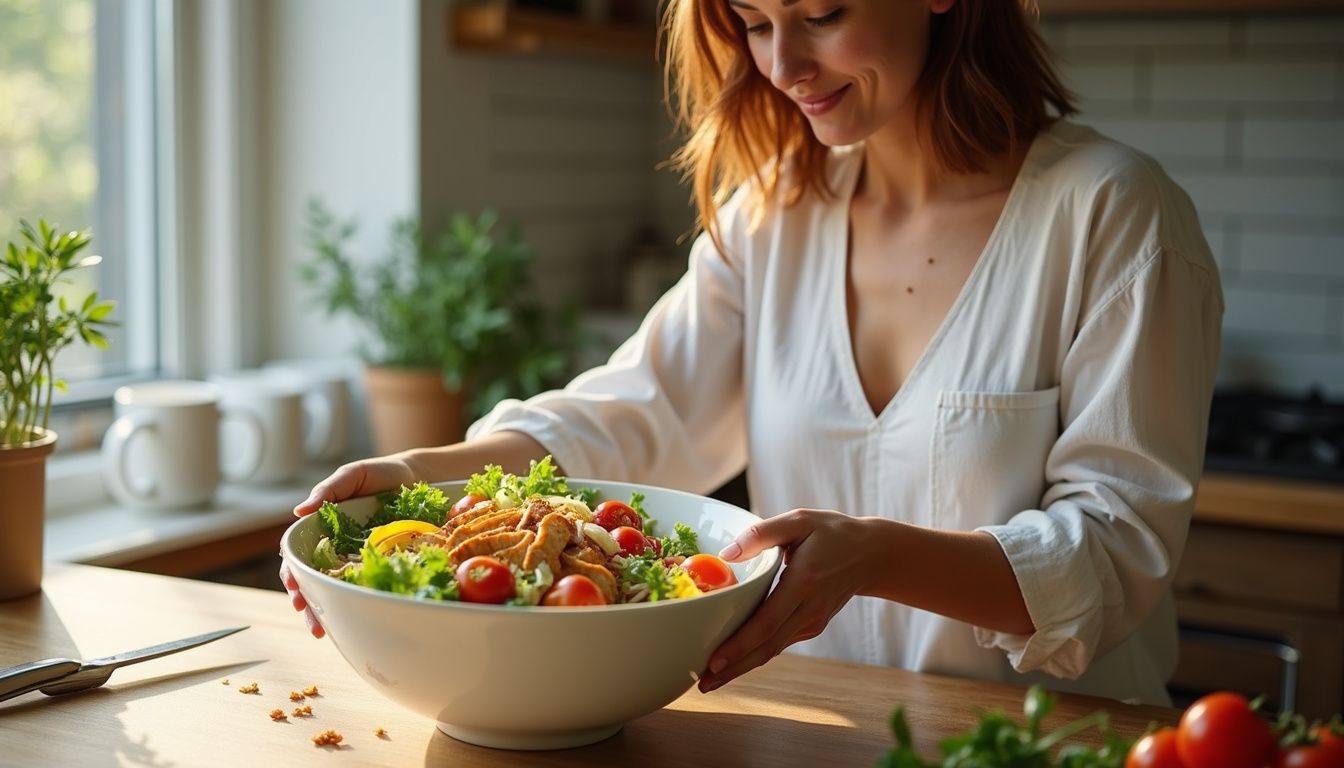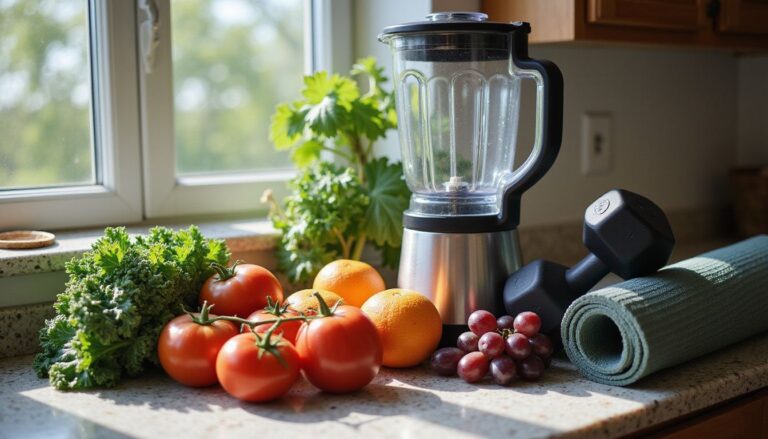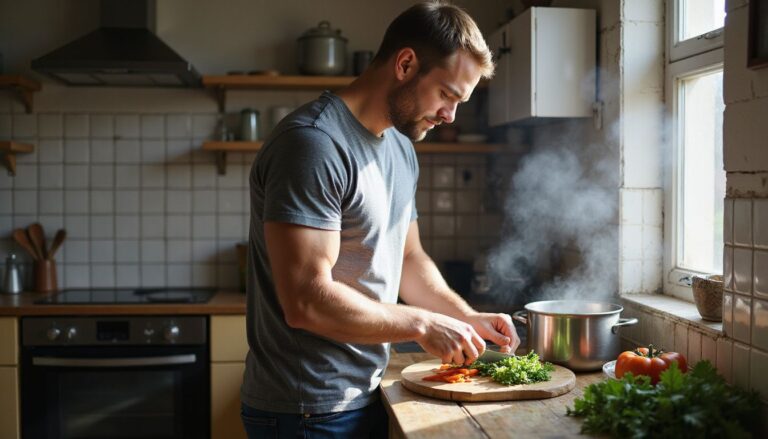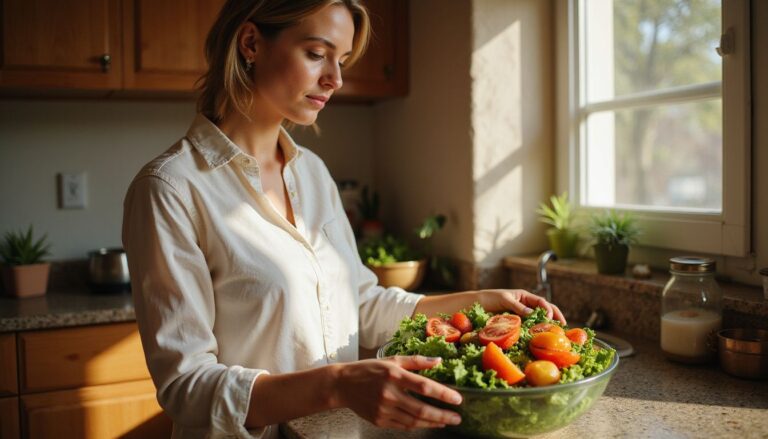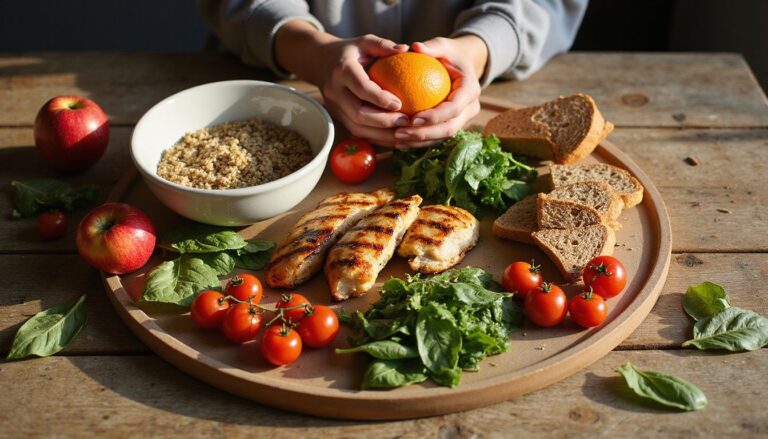10 Diet-Friendly Foods That Help You Lose Weight Fast
Our Nutrition Assistant AI Suite will transform your body. You will lose fat, get toned, and build muscle. Gain confidence and optimal health.
Trying to lose weight can feel overwhelming. The good news is that some foods make it simpler by helping you feel full on fewer calories. Research shows that protein and fiber are especially helpful for appetite control and steady energy.
This guide highlights 10 diet-friendly foods that help you lose weight, based on studies and expert advice. You will find clear tips you can use today to start a healthy weight plan that fits your routine.
Key Takeaways
- High-protein foods like eggs increase fullness for hours, which can lower total calorie intake and protect muscle during a diet.
- Leafy greens such as spinach are low in calories and high in water and fiber, so you can eat generous portions and still stay within your calorie target.
- Fatty fish like salmon provide omega-3 fats that support metabolic health and may reduce inflammation; aim for two servings per week.
- Lentils and beans deliver about 8 grams of protein and 8 grams of fiber per cup, which supports fullness, gut health, and weight control.
- Foods with high water content, such as broth-based soups and fruit, plus whole grains like oats, help manage appetite while keeping calories in check.

Why Are Eggs Good for Weight Loss?
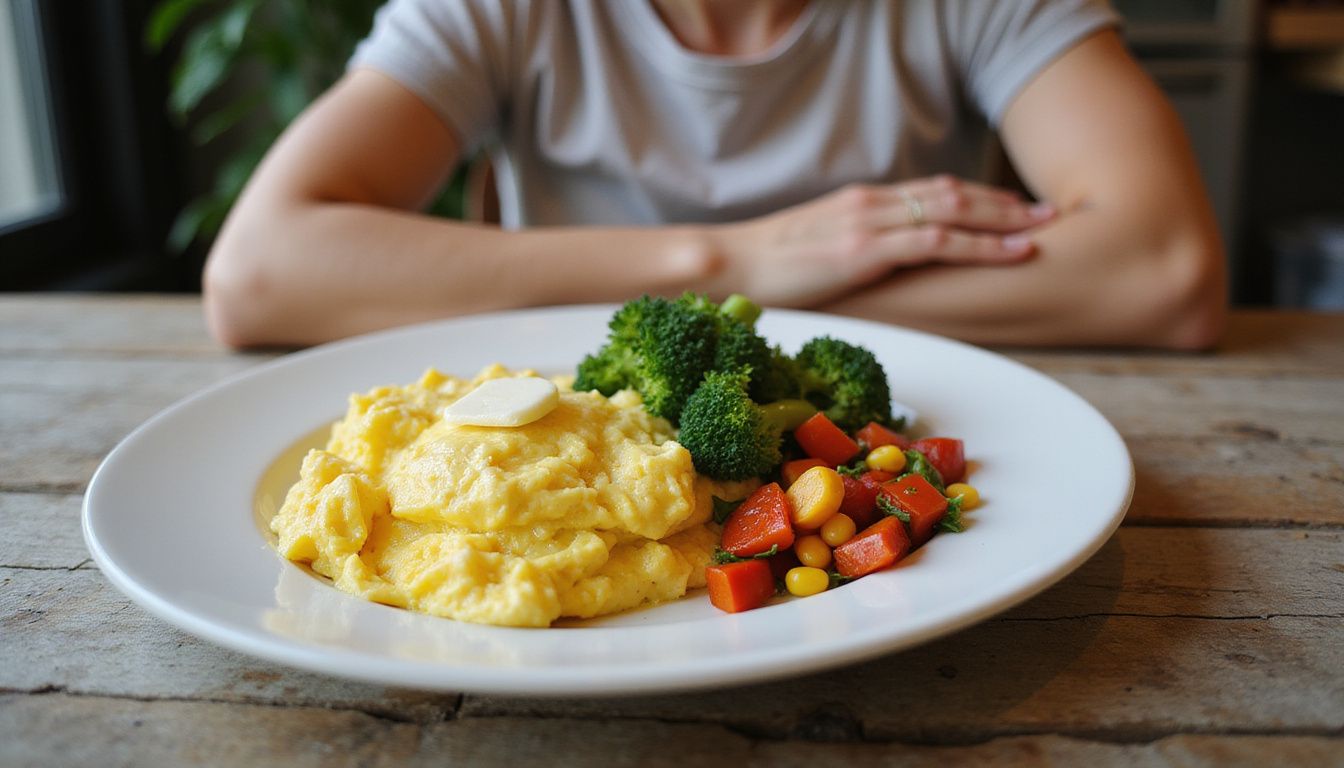
Eggs are rich in protein and healthy fats, so they keep you full and satisfied. Studies report that an egg breakfast can reduce hunger for up to four hours compared with cereal and juice. That fullness makes it easier to eat fewer calories later in the day.
Eggs are a complete protein, which means they contain all essential amino acids your body needs. This helps you maintain muscle while you lose weight. Pair eggs with fiber-rich vegetables for even better appetite control.
A filling breakfast can set the tone for healthy eating all day long.
On busy mornings, scrambled eggs with spinach keep me satisfied until lunch.
What Makes Leafy Greens Ideal for a Low-Calorie Diet?
Leafy greens like spinach, romaine, and kale are low in calories and high in nutrients. One cup of raw spinach has about seven calories, yet it delivers vitamins A, C, and K plus minerals like iron and magnesium.
These greens contain lots of water and fiber, which add volume to meals without adding many calories. They also contain thylakoids, small structures in plant leaves that may help curb appetite. While research continues, many people find greens helpful for portion control.
Leafy greens fit any healthy eating plan, including the Mayo Clinic Diet. They let you build a full plate that supports a calorie deficit while still meeting your nutrition needs.
How Does Eating Fish Support Weight Loss?
Fish gives you high-quality protein that boosts fullness and supports your metabolism. Fatty fish such as salmon, sardines, tuna, and mackerel also supply omega-3 fats. These fats are linked with better heart and metabolic health.
Protein has a higher thermic effect than carbs or fat, which means your body burns more calories digesting it. Many types of seafood also provide iodine, a mineral that supports your thyroid, the organ that helps regulate metabolism.
Evidence suggests omega-3s may help improve markers tied to metabolic syndrome. Swapping a red meat dinner for grilled salmon once or twice a week helps many people stay full on fewer calories.
Benefits of Cruciferous Vegetables for Fullness and Fiber
Broccoli, cauliflower, Brussels sprouts, and cabbage bring fiber, water, and crunch. They add volume to your plate, so you feel satisfied without a calorie spike. That makes portion control easier during your weight loss plan.
Fiber slows digestion and supports a healthy gut. Research links higher fiber intake with greater fullness and lower overall calorie intake. Cruciferous veggies also contain helpful plant compounds that support metabolic and digestive health.
Roasted broccoli gives a salty crunch I used to crave from chips, and it keeps me full through the afternoon.
Why Choose Chicken Breast and Lean Meats for Satiety?
Skinless chicken breast and lean cuts like pork tenderloin or flank steak deliver protein and iron with less saturated fat. You feel full longer on fewer calories, which can support steady weight loss.
Studies show high-protein meals reduce hunger and help you stick with calorie goals. Grill, bake, or roast meats to avoid extra oil. Keep portions moderate, especially with red meat, to support long-term health.
Pair lean protein with vegetables and a whole grain. That mix of protein, fiber, and slow-digesting carbs helps control appetite between meals.
How Do Potatoes and Root Vegetables Help You Feel Satisfied?
Boiled white potatoes rank at the top of the Satiety Index, a tool that measures how filling foods are. Potatoes and other roots, like carrots and beets, are rich in water and fiber, which boosts fullness without many calories.
Cook and cool white potatoes to increase resistant starch, a type of carb that acts like fiber in the gut. It may support a healthy weight by improving fullness. Bake or roast instead of frying to keep calories lower.
Roasted sweet potato cubes with leafy greens or grilled chicken make a simple meal that keeps energy steady through busy afternoons.
What Are the Weight Loss Benefits of Beans and Legumes?
Lentils, black beans, chickpeas, and kidney beans are budget-friendly and filling. A cup often provides about 8 grams of protein and 8 grams of fiber. This duo helps preserve muscle and keeps you satisfied for hours.
Beans also contain resistant starch and key minerals like iron, magnesium, and potassium. Research links regular legume intake with better metabolic health and lower body weight in adults and children.
Add beans to soups, salads, tacos, or grain bowls. They fit many diets and help lower total calories without losing important nutrients.
How Can Soups Help You Stay Full on Fewer Calories?
A small bowl of broth-based vegetable soup before your main course can reduce how much you eat at that meal. In a clinical trial, people who started with vegetable soup consumed fewer total calories than those who skipped it.
Choose clear or tomato-based soups instead of creamy versions. The high water content increases food volume and fullness while keeping calories low. Load your pot with greens, carrots, and broccoli for extra fiber.
I like to batch-cook a simple vegetable soup on Sundays. Having it ready for busy nights helps me avoid overeating at dinner.
Why Is Cottage Cheese a Good Low-Calorie Protein Source?
Low-fat cottage cheese is rich in protein and relatively low in calories. One cup typically provides about 24 grams of protein for around 180 calories. That is a strong protein-to-calorie ratio for muscle support during weight loss.
Cottage cheese also supplies calcium, which supports bone health. Some studies suggest dairy calcium may play a role in weight control in adults, especially women.
Use cottage cheese as a snack with fruit, or stir it into salads. Cottage cheese with blueberries is a quick breakfast that keeps you full until lunch.
What Are the Health Benefits of Avocados for Weight Loss?
Avocados combine heart-healthy monounsaturated fat, water, and fiber. This mix increases satiety, which can help you eat less at later meals. The fat also helps you absorb fat-soluble vitamins like A, D, E, and K from other foods.
Avocados are calorie-dense, so portion control matters. A small serving, such as one third to one half of a fruit, works well for many plans.
I like a few avocado slices on salads or whole-grain toast. It adds creaminess that reduces the urge for heavier dressings or spreads.
How Can Nuts Serve as a Satiating Snack Option?
Almonds, walnuts, and pistachios are compact snacks that deliver healthy fats, protein, and fiber. A one-ounce serving, about a small handful, usually has 160 to 200 calories and keeps hunger in check longer than many processed snacks.
Regular nut intake is linked with better metabolic markers and heart health. Keep portions modest to balance calories. Pair a handful with Greek yogurt or cottage cheese for a higher-protein snack after a workout.
I keep measured almond packs at my desk. They help me avoid evening overeating.
References: 1) de Souza RGM et al., Health Benefits of Nut Consumption. 2) Liu G et al., Nut Consumption and Cardiovascular Risk in Diabetics, 2019. 3) Khalili L et al., Nuts Improve Metabolic Biomarkers, 2022.
Why Are Whole Grains Important for Sustained Energy?
Whole grains like oats, brown rice, farro, and quinoa digest slowly. They provide more fiber and protein than refined grains, which supports longer-lasting fullness and steady energy.
People who eat more whole grains tend to weigh less and show healthier inflammation markers. Whole grains can also help steady blood sugar, which reduces crashes and cravings.
Swapping white rice for brown rice during lunch helped me avoid afternoon slumps and cut snacking.
How Do Chili Peppers Boost Metabolism with Capsaicin?
Chili peppers contain capsaicin, the compound that brings heat. Capsaicin can slightly raise body temperature and may increase calorie burn for a short time. Some research suggests it also enhances feelings of fullness.
Add chopped chili to stir-fries, eggs, or grain bowls. Use a small amount if you are sensitive to spice. More heat is not always better, and too much can irritate your stomach.
What Makes Fruits a Sweet, Nutritious, Low-Calorie Choice?
Whole fruit gives you flavor, fiber, and hydration for relatively few calories. For example, a cup of grapes has about 104 calories, while a cup of raisins has about 480 calories. Prioritize fresh or frozen fruit without added sugar.
Berries, apples, peaches, and oranges provide fiber that slows sugar absorption. That helps you feel full and supports healthy blood sugar levels.
I often replace sugary desserts with a bowl of fruit. It satisfies my sweet tooth and supports my goals.
How Do Chia Seeds Support Weight Loss with Fiber and Omega-3s?
Chia seeds are tiny but powerful. They offer fiber, plant-based omega-3s called ALA, and key minerals. Adding one to two tablespoons to yogurt increased fullness in a small study, which led people to eat less at the next meal.
Stir chia into oatmeal, smoothies, or yogurt. They absorb water and swell, which adds volume to meals and helps you stay satisfied.
Why Is Greek Yogurt High in Protein and Probiotics?
Greek yogurt is strained to remove liquid whey. The result is a thicker yogurt with more protein and fewer carbs than regular yogurt. Many brands include live probiotics, helpful bacteria that support gut health and digestion.
Research links probiotic foods with improved metabolic markers. Full-fat options do not necessarily cause weight gain, but low-fat versions can help you manage calories if you are in a deficit.
Use plain Greek yogurt as a base for fruit, cinnamon, or a small sprinkle of nuts. It makes a creamy snack that does not weigh you down.
What Are the Weight Loss Benefits of Broccoli?
Broccoli is low in calories and high in fiber and water. One cup of raw broccoli has about 31 calories and provides vitamin C, vitamin K, and helpful plant compounds.
Steam, roast, or enjoy it raw in salads. Its fiber supports digestion and helps you feel full longer. Many healthy eating plans recommend broccoli as a staple for weight control.
How Does Green Tea Naturally Boost Metabolism?
Green tea contains catechins, antioxidants that may support fat burning and calorie use at rest. Replacing sugary drinks with green tea lowers added sugar while keeping you hydrated.
Some research ties regular green tea intake to reduced belly fat. It is a simple daily habit that pairs well with a balanced diet.
Why Is Oatmeal a Healthy Breakfast for Weight Loss?
Oatmeal is a whole grain with soluble fiber called beta-glucan. This fiber forms a thick gel in your gut, which slows digestion and promotes steady blood sugar. That means fewer mid-morning cravings and longer-lasting energy.
Enjoy hot oats or prep overnight oats. Add berries for fiber and nuts for crunch, but keep portions modest to manage calories.
Oats support heart health and help manage appetite through the morning.
How Are Berries Antioxidant-Rich and Low in Calories?
Berries such as strawberries, blueberries, and raspberries are rich in antioxidants, which help protect cells from damage. They are also low in calories and high in fiber, a valuable mix for weight management.
A cup of sliced strawberries has about 53 calories and more than 3 grams of fiber. Use fresh or unsweetened frozen berries in yogurt, smoothies, or oatmeal.
I add frozen blueberries to hot oats. The berries thaw quickly and add sweetness without extra sugar.
What Makes Almonds a Healthy Fat and Protein Combo?
Almonds supply mostly unsaturated fats, plus fiber and protein. This combo helps regulate appetite and steady blood sugar. A typical serving of 23 almonds offers about 6 grams of protein and 3.5 grams of fiber.
Because nuts are calorie-dense, measure a small handful instead of eating straight from the bag. Sprinkle chopped almonds on salads or yogurt for crunch and satisfaction.
How Do Water-Rich Foods Help You Stay Hydrated and Full?
Foods with high water content have low energy density. That means you can eat a larger portion for fewer calories. Examples include oranges, grapes, carrots, cucumbers, spinach, and broth-based soups.
Filling half your plate with water-rich fruits and vegetables helps control portions of calorie-dense items. This strategy supports a calorie deficit without leaving you hungry.
A simple hydration target is to drink about half your body weight in ounces of water each day. Include water-rich foods to make that goal easier.
Why Are Lentils a Versatile, Nutrient-Packed Food?
Lentils are a quick-cooking legume that blends into many dishes. A cup provides about 8 grams of protein and 8 grams of fiber, plus iron, magnesium, and potassium.
You can toss brown or green lentils into salads, soups, and stews. Red lentils cook fast and are great for smooth soups. Lentils help keep meals affordable while supporting fullness and muscle maintenance.
What Are the Benefits of Low-Fat Milk for Satiety and Calcium?
Low-fat milk offers protein, calcium, and vitamin D with fewer calories than whole milk. One cup adds about 8 grams of protein to your meal or coffee, which supports fullness and muscle health.
Including calcium-rich foods may support weight control in adults. Many people use low-fat milk at breakfast to raise protein and keep portions balanced.
How Is Tempeh a Plant-Based Protein Alternative?
Tempeh is a firm, fermented soybean cake. A 3-ounce serving has about 16 grams of protein and 7 grams of fiber, which helps with satiety. Fermentation can support gut health, and tempeh also provides iron, calcium, and magnesium.
Use tempeh in stir-fries, grain bowls, or sandwiches as a swap for meat. Its hearty texture makes meals satisfying with fewer calories from saturated fat.
Why Are Sweet Potatoes Nutrient-Rich and Filling?
Sweet potatoes supply fiber and slow-digesting carbs, which support steady blood sugar and long-lasting energy. A medium baked sweet potato has about 3.8 grams of fiber, plus beta-carotene, vitamin C, and potassium.
Bake, roast, or boil without heavy toppings to keep calories low. Sweet potato wedges can replace fries and still feel hearty.
On active weeks, roasted sweet potatoes keep me full without making me sluggish.
How Can Tofu Be a Versatile, Low-Calorie Protein?
Tofu is a complete plant protein, meaning it includes all essential amino acids. A 3-ounce serving has about 76 calories and 8 grams of protein. It also provides calcium and iron, which support bones and energy.
Tofu takes on flavors easily. Press extra-firm tofu, then bake or stir-fry with spices. Use it in scrambles, tacos, noodle bowls, or salads.
What Makes Quinoa a Complete Protein and Fiber Source?
Quinoa is a whole grain that offers complete protein along with fiber and minerals. One cooked cup provides about 8 grams of protein and 5 grams of fiber, plus magnesium, iron, and potassium.
It is naturally gluten-free and easy to add to bowls, salads, or soups. Many people find quinoa bowls with vegetables and a lean protein keep them full through the afternoon.
How Can Dark Chocolate Be a Healthy Treat in Moderation?
Plain dark chocolate contains antioxidants and usually less sugar than milk chocolate. A small portion can satisfy a sweet craving without derailing your plan.
Keep servings to about one ounce. Enjoy it alone, with fruit, or stirred into Greek yogurt. A mindful treat can reduce the urge to overeat later.
Tips for Incorporating These Foods into Your Diet
Use these simple strategies to add diet-friendly foods to your day and support your goals.
How Can You Plan Balanced Meals for Weight Loss?
Use the Mayo Clinic Healthy Weight Pyramid as a visual guide. Fill half your plate with vegetables and fruit, one quarter with lean protein, and one quarter with whole grains.
Choose proteins such as chicken breast, fish, tofu, cottage cheese, or Greek yogurt. Include a small serving of healthy fat like avocado or olive oil for satisfaction.
Pick snacks that combine protein and fiber, such as an apple with peanut butter or yogurt with berries. If you enjoy toast at breakfast, choose whole-grain bread topped with fruit or yogurt instead of sugary spreads.
Keep meals simple. Rotate ingredients for variety and nutrients across the week.
Why Combine Protein, Fiber, and Healthy Fats?
Protein, fiber, and healthy fats work better together than alone. Protein takes more energy to digest, which can slightly raise calorie burn and increase fullness. Fiber slows digestion, which steadies blood sugar and appetite. Healthy fats help control cravings and make meals satisfying.
For breakfast, whole-grain toast with nut butter and berries offers all three. Many people notice fewer mid-morning cravings with this approach.
What Are Effective Ways to Practice Portion Control?
Use smaller plates and bowls, especially for calorie-dense foods like nuts and cheese. Drink a glass of water before meals to take the edge off hunger.
Fill half your plate with vegetables. This allows smaller portions of higher-calorie items like pasta or rice while keeping you satisfied. Eat slowly, set down your fork between bites, and check your hunger level before refilling your plate.
Additional Healthy Habits to Support Weight Loss
Food choices work best with a few daily habits that support your plan and energy.
How Much Water Should You Drink for Weight Loss?
Drinking enough water may help curb appetite and can slightly increase calorie burn for a short time. A simple target is to drink about half your body weight, in ounces, each day.
Have a glass before meals to support portion control. Carry a reusable bottle so staying hydrated is easy.
Why Is Staying Physically Active Important?
Regular physical activity supports a healthy metabolism and preserves muscle while you lose weight. It also lowers the risk of conditions such as type 2 diabetes and heart disease.
Build more movement into your day. A brisk walk after lunch or dinner adds up over time.
What Foods Should You Avoid to Lose Weight?
Limit fried foods, pastries, candy, and chips. These foods are high in calories and low in nutrients, and they do not keep you full for long.
Choose whole grains over refined grains. For example, pick oatmeal or brown rice instead of sugary cereal or white rice. Small changes like these improve energy and reduce cravings.
Frequently Asked Questions
You may have specific questions about how these foods fit your plan. Seek guidance from a health professional if you have a medical condition, take medication, or need a personalized eating plan.
Which Foods Help Burn Belly Fat?
There is no single belly fat burner, but certain foods support fat loss. Focus on lean proteins like eggs and fish, high-fiber vegetables such as leafy greens and broccoli, and slow-digesting carbs like potatoes and oats.
Soups, beans, and fruit add volume and fiber for few calories. Build most meals around these foods to control hunger while you lower total calories.
How Do These Foods Promote Weight Loss?
Protein from eggs, fish, chicken breast, and lean meats raises fullness and helps preserve muscle. Fiber from leafy greens, cruciferous vegetables, beans, and whole grains slows digestion and reduces hunger between meals.
Pairing these foods makes portion control easier while maintaining nutrition. You stay satisfied on fewer calories, which supports a healthy rate of weight loss.
Can These Foods Replace a Complete Healthy Diet?
No single food group covers all nutrients your body needs. You still need a mix of whole grains, lean proteins, fruits, vegetables, healthy fats, and dairy or fortified alternatives.
For example, pairing beans with whole grains gives you a broader amino acid profile. Calcium from dairy or fortified foods supports bones, which plant foods alone might not provide in sufficient amounts.
Conclusion
Adding diet-friendly foods like eggs, leafy greens, beans, fish, and whole grains helps you feel full on fewer calories and can help you lose weight. These choices deliver protein, fiber, and water, which support appetite control and steady energy.
Start with simple swaps, such as soup before dinner, salmon instead of a burger, or oats topped with berries. If you have a medical condition, talk with a health professional before making major changes. Small steps, done daily, build healthy habits that last.
FAQs
1. What are some diet-friendly foods that help you lose weight fast?
Foods such as leafy greens, lean poultry, Greek yogurt, beans, and berries support weight loss. These options provide high fiber or protein content with fewer calories per serving. Studies show that eating more of these foods can increase fullness and reduce calorie intake.
2. How do these foods promote faster weight loss?
Leafy greens like spinach contain few calories but offer many nutrients and fiber, which helps control hunger. Lean poultry provides protein that supports muscle maintenance during dieting. Beans deliver both fiber and plant-based protein for lasting satiety.
3. Can I eat fruit while trying to lose weight quickly?
Yes; fruits like berries have low sugar compared to other fruits yet supply antioxidants and vitamins essential for health. Research suggests people who include moderate amounts of fruit in their diets often achieve better long-term results than those who avoid them entirely.
4. Is it necessary to count calories when eating diet-friendly foods?
Tracking portions remains important even with healthy choices since overeating any food may slow progress toward your goal weight. For example, nuts are nutrient-dense but also high in energy; a small handful is usually enough for a snack.
Summary: Choosing nutrient-rich items such as leafy vegetables, lean meats, Greek yogurt, beans, and certain fruits can aid quick weight loss by increasing fullness without excess calories or sugar. Portion awareness ensures continued success on your journey toward healthier living.

